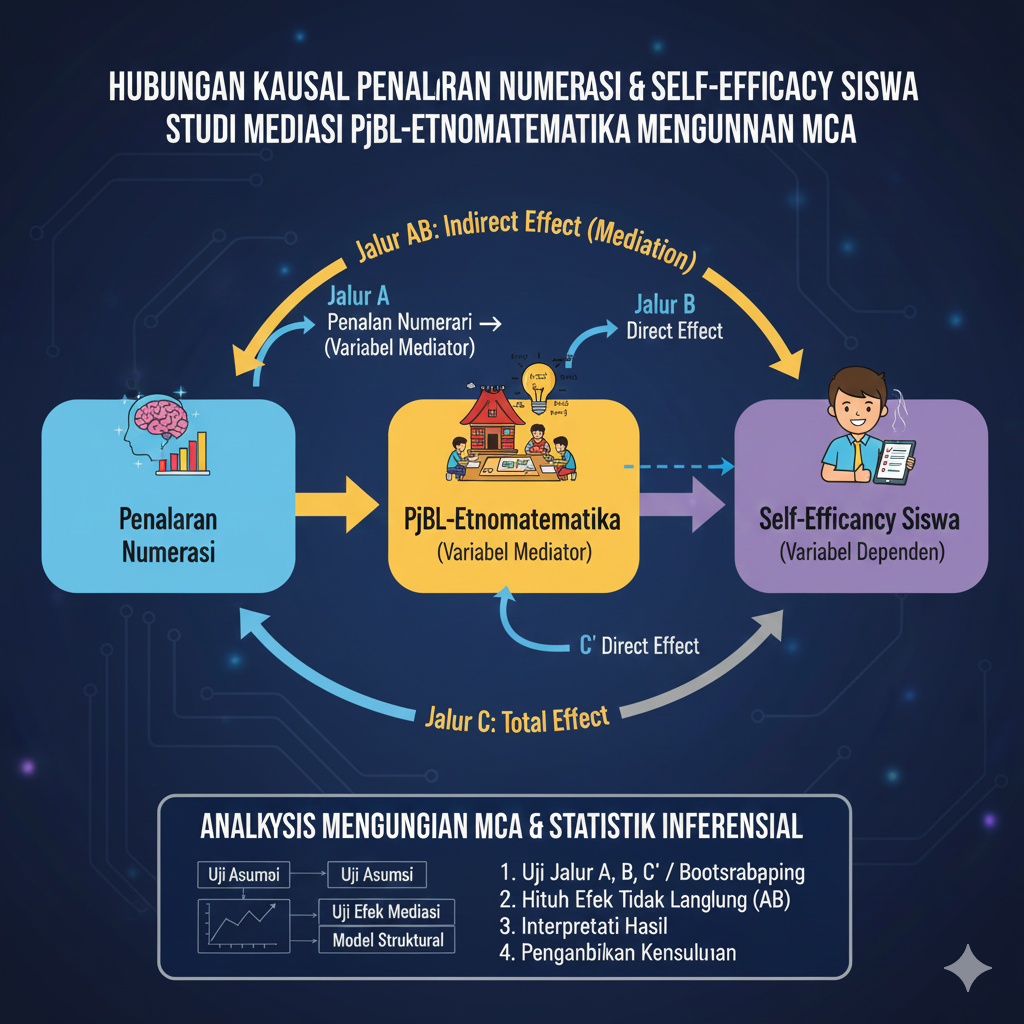Keywords: Penalaran Numerasi, Self-Efficacy, Mediasi Penuh, PjBL-Etnomatematika, Limit Fungsi Aljabar, MCA
Abstract
Penelitian ini bertujuan menganalisis model hubungan kausal antara Pendekatan PjBL-Etnomatematika menggunakan Media MCA (X) terhadap Penalaran Numerasi (Y) dengan Self-Efficacy (M) sebagai variabel mediasi. Latar belakang utama adalah rendahnya Penalaran Numerasi siswa yang diduga kuat dipengaruhi oleh Self-Efficacy yang rendah, khususnya pada materi abstrak Limit Fungsi Aljabar. Penelitian ini menggunakan desain Survei Analitik Korelasional dengan teknik Analisis Jalur (Path Analysis). Data dikumpulkan dari siswa SMA yang telah mengimplementasikan pendekatan PjBL-Etnomatematika (MCA). Hasil uji kualitas model menunjukkan kecocokan yang baik (Goodness-of-Fit). Hasil analisis kausalitas menunjukkan bahwa Self-Efficacy Siswa berperan sebagai Mediator Penuh (Full Mediator). Koefisien jalur langsung dari PjBL-Etnomatematika ke Penalaran Numerasi tidak signifikan ), sedangkan Efek Tidak Langsung ) adalah signifikan (interval kepercayaan tidak mengandung nol). Temuan ini memvalidasi Social Cognitive Theory (SCT) Bandura, menunjukkan bahwa Pendekatan PjBL-Etnomatematika tidak secara langsung meningkatkan Penalaran Numerasi, melainkan harus melalui peningkatan Self-Efficacy (yang dipicu oleh Mastery Experience dan Vicarious Experience). Implikasi praktisnya adalah perlunya fokus pada penguatan dimensi afektif sebagai prasyarat utama untuk peningkatan kompetensi numerasi kognitif
References
Afifah, A., Ainiyah, D., & Dehham, S. H. (2024). Interactive Digital Media PanPinRu as an Effort to Increase Interest in Learning Students in Linear Equations of One Variable, 2(December), 185–188.
Akbar, M. (2021). The dynamic association between healthcare spending, CO2 emissions, and human development index in OECD countries: evidence from panel VAR model. Environment Development and Sustainability, 23(7), 10470–10489. http://doi.org/10.1007/s10668-020-01066-5
Darmayanti, R., In, A., Afifah, A., Verliana, A., & Nurmaltasari, D. (2023). Analysis of the Need for Pizzaluv- Math Learning Media So that Students Can Easily Learn the Limits of Trigonometric Functions, 1(3), 211–220.
Hou, J., Yang, X., & Panek, E. (2020). How about playing games as a career? The evolution of E-sports in the eyes of mainstream media and public relations. International Journal of Sport …. Retrieved from https://journals.humankinetics.com/view/journals/ijsc/13/1/article-p1.xml?content=contributorNotes-6971
Kim, H. (2022). Investigating the Roles of the Four Sources of Self-Efficacy Beliefs in an EFL Listening Context. Theory and Practice of Second Language Acquisition, 8(2). http://doi.org/10.31261/TAPSLA.11581
Neumayer, C. (2022). Content, Form, and Reception: Perspectives from Digital Media Data. Creating A More Transparent Internet the Perspective Web, 143–155. http://doi.org/10.1017/9781108641104.011
Paulus, F. W., Hübler, K., Mink, F., & Möhler, E. (2021). Emotional dysregulation in preschool age predicts later media use and gaming disorder symptoms in childhood. Frontiers in Psychiatry. http://doi.org/10.3389/fpsyt.2021.626387
Qomaria, N., Afifah, A., & Manivannan, R. (2025). Identification of Junior High School Students â€TM Experiences in Using Question Card Media for Algebra Learning, 3(April), 7–10.
Qomariyah, S., Darmayanti, R., Rosyidah, U., & ... (2023). … and essay problem grids on three-dimensional material: Development of instruments for measuring high school students’ mathematical problem-solving ability. JEMS: Jurnal Edukasi …. Retrieved from https://www.researchgate.net/profile/Rani-Darmayanti-3/publication/390844836_Indicators_and_Essay_Problem_Grids_on_Three-Dimensional_Material_Development_of_Instruments_for_Measuring_High_School_Students’_Mathematical_Problem-Solving_Ability/links/6848a86
Rabaglietti, E., Lattke, L. S., Tesauri, B., Settanni, M., & De Lorenzo, A. (2021). A Balancing Act During Covid-19: Teachers’ Self-Efficacy, Perception of Stress in the Distance Learning Experience. Frontiers in Psychology, 12. http://doi.org/10.3389/fpsyg.2021.644108
Rahayu, S., Rahmadani, E., Syafitri, E., Prasetyoningsih, L. S. A., Ubaidillah, M. F., & Tavakoli, M. (2022). Teaching with Technology during COVID-19 Pandemic: An Interview Study with Teachers in Indonesia. Education Research International, 2022. http://doi.org/10.1155/2022/7853310
Reichenberg, M., Thunberg, G. C., Holmer, E., Palmqvist, L., Samuelsson, J., Lundälv, M., … Heimann, M. (2023). Will an app-based reading intervention change how teachers rate their teaching self-efficacy beliefs? A test of social cognitive theory in Swedish special educational settings. Frontiers in Education, 8. http://doi.org/10.3389/feduc.2023.1184719
Rizqi, P. A. D., Darmayanti, R., & ... (2023). Problem Solving Analysis Through Tests in View Of Student Learning Achievement. … of Learning and …. Retrieved from https://jurnal.piramidaakademi.com/index.php/ijles/article/view/26
Sekaryanti, R., Darmayanti, R., Choirudin, C., & ... (2022). Analysis of mathematics problem-solving ability of junior high school students in Emotional Intelligence. Jurnal …. Retrieved from https://www.academia.edu/download/105908339/4944-Article_Text-22385-2-10-20230210.pdf
Syahrizal, H., & Jailani, M. S. (2023). Jenis-Jenis Penelitian Dalam Penelitian Kuantitatif dan Kualitatif. Jurnal QOSIM : Jurnal Pendidikan, Sosial & Humaniora, 1(1), 13–23. http://doi.org/10.61104/jq.v1i1.49
William, J. (2024). Development of educational game as a media to raise public awareness of illegal animal trafficking issue in Indonesia. Procedia Computer Science, 245, 337–345. http://doi.org/10.1016/j.procs.2024.10.259

Published
How to Cite
Issue
Section
License
Copyright (c) 2023 vicky Risnanda, Mas'odi Mas'odi, Ani Afifah, Rani Darmayanti

This work is licensed under a Creative Commons Attribution-ShareAlike 4.0 International License.
 https://doi.org/10.61650/alj.v1i2.923
https://doi.org/10.61650/alj.v1i2.923







